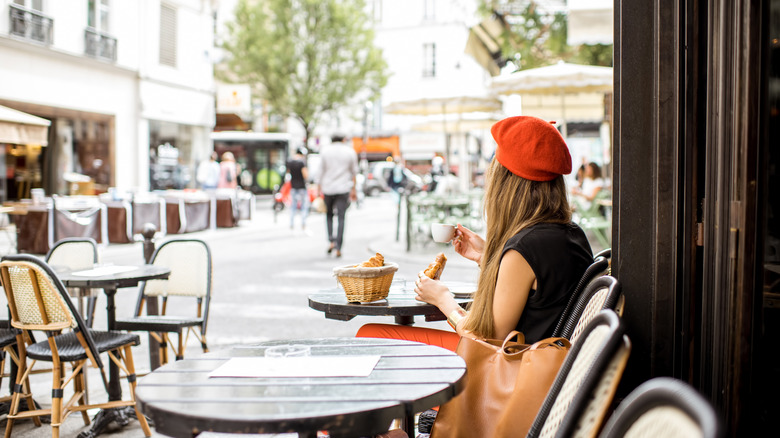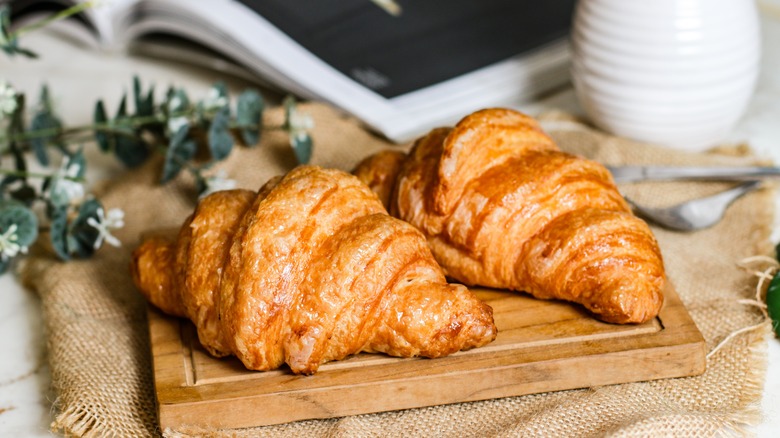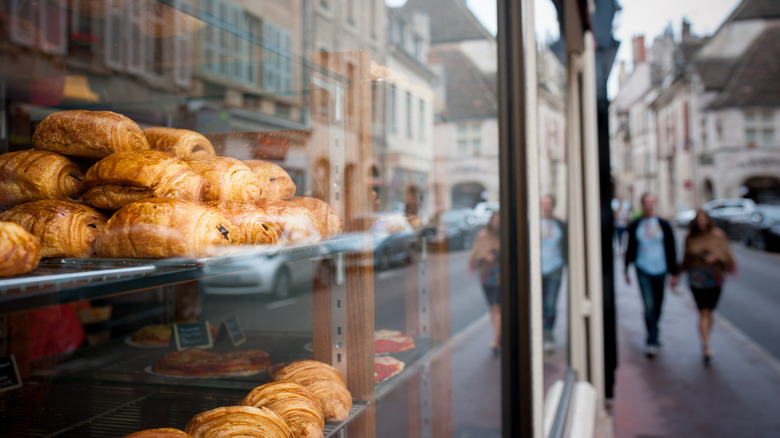Your Croissant Won't Be As Tasty If You Make This Common Ordering Mistake In France
The quintessential trip to the "City of Lights" wouldn't be complete without a photo underneath the Eiffel Tower, sprawled on a plaid picnic blanket, nibbling away on France's most iconic pastry — the croissant. To some, the term "croissant" translates to any given crescent-shaped roll displayed in a Starbucks window. However, Parisians know better. The best croissants in town are those made from a buttery confection rather than artificial substitutes. There's a fine line between those who order acceptable, elongated croissants and the out-of-town guests who unknowingly ask for curved, crescent-shaped croissants.
While it may not be officially written down on paper, there's an implicit French law among pastry chefs — only croissants baked with real butter can be straight. That's right. A croissant's shape is what distinguishes the flaky, melt-in-your-mouth pastries made with butter from the curved variety made with substitution fats, like oil or margarine.
If you've never had the pleasure of indulging in an authentic French croissant, it should be at the top of your French bucket list. It's always best to refer to your pastry of choice by its proper French moniker. The croissant au beurre is made from dough that contains pure butter, while the counterfeit croissant ordinaire is crafted from oil, margarine, or some combination of the two. If you want to experience Paris like a Parisian, adhere to the proper way of ordering a croissant, entering with a "bonjour" and heading out the door with a "merci" with your croissant au beurre in hand.
The science of croissants
Croissants are the masterpieces of French boulangeries. These flaky pastries are part of a larger spread of viennoiseries — that is, Parisian goods made from a simple concoction of yeast-leavened dough, butter, eggs, and milk (keep in mind, the keyword is butter). Brioches, pain au chocolats, pain au raisins, kouglofs, and croissants all fall under this category. One of the most important European life lessons you can master is distinguishing a croissant au beurre from its lower-in-status cousin, the croissant ordinaire. Oftentimes, the smell of the boulangerie is more than enough to decipher authentic Parisian goods made with real butter. Crumbs are another sure sign your morning croissant boasts natural, wholesome ingredients. Most importantly, your croissant should be straight, not tightly curved.
Baking is a science, and croissants are no exception. Forming the delicate interior of a croissant au beurre is the work of careful artisanship, and lamination creates those intricate layers of a croissant's inner shape. Bakers knead, fold, and alternate the layers of the dough, resulting in a crumbly, flaky work of art. The process of lamination is essentially a waste if butter is not involved in the baking method. Once the pastry begins to rise in the oven, the solid fats in the butter evaporate into steam, causing the croissant to puff up and take its true form as a fried, multi-layer treat. Without butter, the final product will be far less flaky and puffy.
The evolution of croissants
Contrary to popular belief, the French croissant is not actually French in origin. This delicious baked good was inspired by the kipfel, an Austrian pastry that is believed to have been first introduced shortly after Austria defeated the Ottoman Empire in 1683. The kipfel's shape was modeled after the crescent-like emblem on the Ottoman flag. There's some speculation surrounding the story of how the kipfel made its way to France and initiated the nation's croissant obsession, suggesting that the introduction of a Viennese bakery in Paris in the late 1800s inspired the creation.
Today, the streets of Paris are overwhelmed with inventive pastry chefs, eager to make their mark on the city's obsession with croissants. While boulangeries are a dime a dozen in Paris, a select few stand out from the crowd. Laurent Duchêne Paris 13ème captured the attention of Vogue Magazine, which declared this bakery the number one spot for a croissant in Paris. The pastry case in this boulangerie is rich with traditional butter, praline swirl, and chocolate-filled croissants. Let's just say you won't be disappointed with your pick of pastry at this boulangerie! Cédric Grolet Opéra is a close second, and its croissants garnered a wealth of attention on social media. This boulangerie is stocked with only a limited quantity of buttery baked goods, making an early morning pastry run the essential tip to securing one of these famous croissants. You won't have to decide between curved and straight, as these authentic bakeries only do the traditional croissant au beurre.


